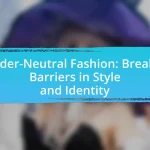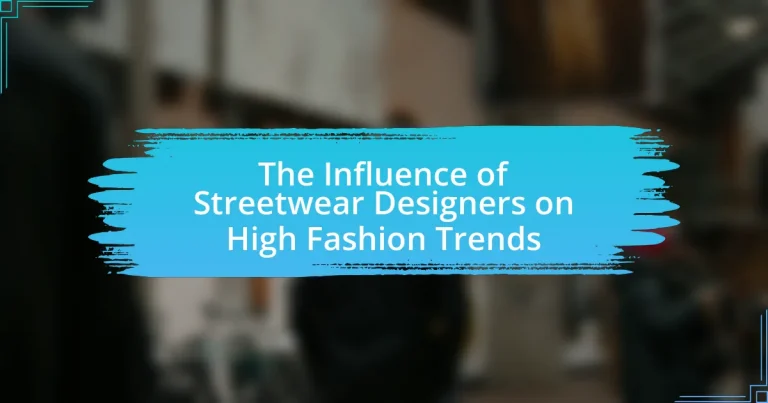The article examines the significant influence of streetwear designers on high fashion trends, highlighting how casual aesthetics, bold graphics, and a focus on youth culture have reshaped luxury fashion. It discusses the emergence of streetwear from urban culture, its roots in movements like hip-hop and skateboarding, and the establishment of its identity through collaborations with luxury brands. Key characteristics such as inclusivity, cultural relevance, and the impact of social media are explored, alongside the challenges streetwear designers face in the high fashion landscape. The article also addresses the implications of cultural appropriation and offers practical strategies for streetwear designers to succeed in the luxury market while maintaining their unique identity.
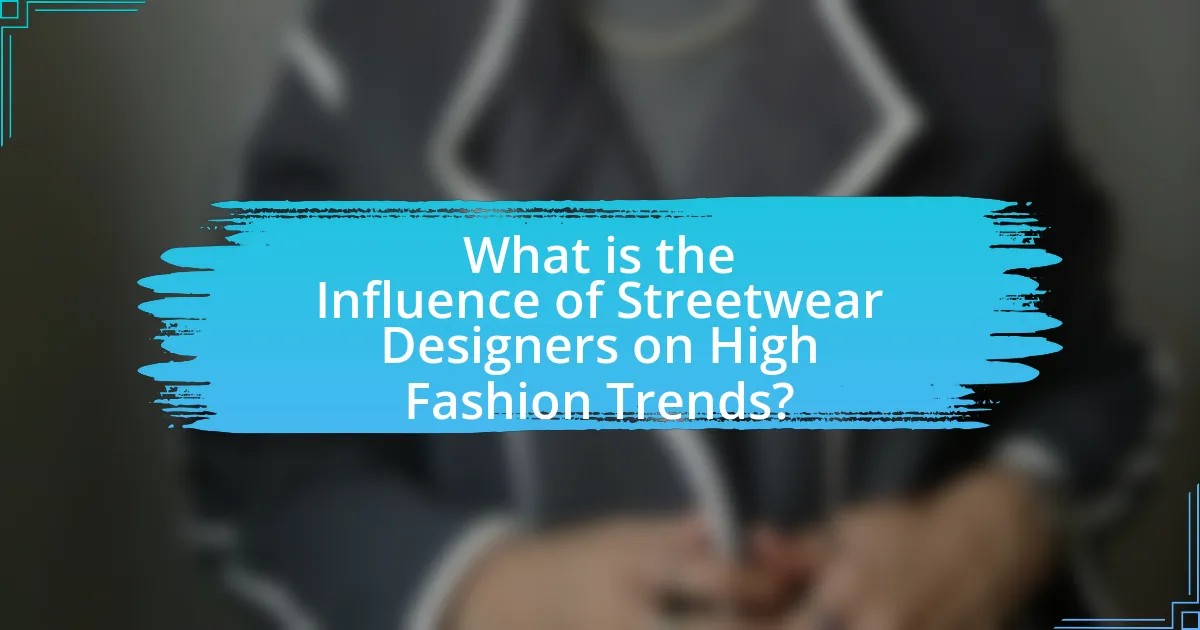
What is the Influence of Streetwear Designers on High Fashion Trends?
Streetwear designers significantly influence high fashion trends by introducing casual aesthetics, bold graphics, and a focus on youth culture. This shift is evident in collaborations between streetwear brands and luxury fashion houses, such as the partnership between Supreme and Louis Vuitton in 2017, which generated substantial media attention and sales. Additionally, streetwear’s emphasis on inclusivity and accessibility has prompted high fashion to adopt more relaxed silhouettes and street-inspired designs, as seen in collections by designers like Virgil Abloh at Off-White and his subsequent role at Louis Vuitton. The blending of these styles has reshaped consumer expectations and market dynamics, making streetwear a pivotal force in contemporary fashion.
How did streetwear emerge as a significant force in fashion?
Streetwear emerged as a significant force in fashion through its roots in urban culture, particularly influenced by skateboarding, hip-hop, and youth subcultures in the late 20th century. The rise of brands like Stüssy in the 1980s and Supreme in the 1990s established a new aesthetic that combined casual wear with bold graphics and logos, appealing to a generation seeking authenticity and self-expression. This movement gained momentum as celebrities and influencers began to adopt streetwear styles, further legitimizing its presence in mainstream fashion. By the 2010s, collaborations between streetwear brands and luxury fashion houses, such as Louis Vuitton’s partnership with Off-White, solidified streetwear’s status as a vital component of high fashion, demonstrating its influence on contemporary trends and consumer behavior.
What cultural movements contributed to the rise of streetwear?
The rise of streetwear was significantly influenced by cultural movements such as hip-hop, skateboarding, and punk. Hip-hop culture, emerging in the late 1970s and 1980s, popularized casual and expressive clothing styles, which became synonymous with the genre’s identity. Skateboarding culture, particularly in the 1980s and 1990s, introduced a laid-back aesthetic that emphasized individuality and rebellion, further shaping streetwear’s casual vibe. Additionally, the punk movement of the 1970s contributed to streetwear by promoting anti-establishment attitudes and DIY fashion, which encouraged unique and often provocative styles. These movements collectively established the foundational elements of streetwear, merging music, art, and social commentary into a distinct fashion genre.
How did streetwear brands establish their identity in the fashion industry?
Streetwear brands established their identity in the fashion industry by blending urban culture with high fashion elements, creating a unique aesthetic that resonates with youth culture. This identity was solidified through collaborations with influential artists and designers, such as the partnership between Supreme and Louis Vuitton in 2017, which showcased streetwear’s acceptance in luxury markets. Additionally, streetwear brands utilized social media platforms for marketing, allowing them to engage directly with consumers and build a community around their brand ethos. The rise of limited-edition drops and exclusive releases further reinforced their identity, creating a sense of urgency and desirability that appealed to fashion-forward consumers.
Why are streetwear designers important to high fashion?
Streetwear designers are important to high fashion because they introduce innovative styles and cultural relevance that challenge traditional fashion norms. Their ability to blend casual aesthetics with luxury elements has reshaped consumer expectations and broadened the definition of high fashion. For instance, collaborations between streetwear brands like Off-White and established luxury houses such as Louis Vuitton have generated significant buzz and sales, illustrating the commercial viability of this fusion. Additionally, streetwear’s emphasis on inclusivity and diversity resonates with younger consumers, making it a vital influence in shaping contemporary fashion trends.
What unique perspectives do streetwear designers bring to high fashion?
Streetwear designers bring a fresh, urban perspective to high fashion by emphasizing inclusivity, cultural commentary, and functionality. Their designs often reflect contemporary social issues, making fashion a medium for dialogue, as seen in brands like Off-White, which critiques consumerism and cultural appropriation. Additionally, streetwear’s roots in youth culture and subcultures challenge traditional fashion hierarchies, promoting a more democratic approach to style. This shift is evidenced by collaborations between streetwear brands and luxury houses, such as Louis Vuitton’s partnership with Virgil Abloh, which merges street aesthetics with high-end craftsmanship, illustrating the growing acceptance and influence of streetwear in the luxury market.
How do collaborations between streetwear and high fashion brands influence trends?
Collaborations between streetwear and high fashion brands significantly influence trends by merging distinct aesthetics and expanding market reach. These partnerships often result in innovative designs that attract diverse consumer bases, as seen in the collaboration between Supreme and Louis Vuitton, which generated immense hype and sales, demonstrating the power of blending street culture with luxury fashion. Such collaborations not only elevate the visibility of streetwear within high fashion but also encourage high fashion brands to adopt more casual, accessible styles, thereby reshaping consumer expectations and industry standards.
What are the key characteristics of streetwear that impact high fashion?
The key characteristics of streetwear that impact high fashion include its emphasis on casual aesthetics, cultural relevance, and inclusivity. Streetwear often incorporates elements from youth culture, music, and art, making it a reflection of contemporary societal trends. This cultural resonance allows high fashion brands to connect with younger audiences, as seen in collaborations between luxury labels and streetwear designers like Virgil Abloh’s work with Louis Vuitton. Additionally, streetwear’s focus on comfort and functionality challenges traditional high fashion norms, pushing luxury brands to adopt more relaxed silhouettes and versatile designs. The rise of limited-edition drops and exclusivity in streetwear also influences high fashion’s marketing strategies, creating a sense of urgency and desirability among consumers.
How does the casual aesthetic of streetwear challenge traditional high fashion norms?
The casual aesthetic of streetwear challenges traditional high fashion norms by prioritizing comfort, accessibility, and self-expression over exclusivity and formality. Streetwear brands like Supreme and Off-White have democratized fashion, making it more inclusive and reflective of urban culture, which contrasts sharply with the elitist and often rigid structures of high fashion. This shift is evidenced by the increasing collaboration between streetwear labels and luxury brands, such as Louis Vuitton’s partnership with Virgil Abloh, which blurs the lines between casual and high-end fashion, illustrating how streetwear’s influence is reshaping industry standards.
What role does branding play in the influence of streetwear on high fashion?
Branding serves as a critical conduit through which streetwear influences high fashion by establishing cultural relevance and desirability. Streetwear brands like Supreme and Off-White leverage strong branding strategies that resonate with youth culture, creating a sense of exclusivity and community. This branding not only elevates the perceived value of their products but also prompts high fashion houses to adopt similar marketing tactics, such as collaborations and limited releases, to attract a younger demographic. For instance, the collaboration between Louis Vuitton and Off-White’s Virgil Abloh exemplifies how high fashion integrates streetwear branding to remain relevant in a rapidly evolving market. This intersection of branding and fashion illustrates the transformative impact streetwear has on high fashion, driving it to adapt and innovate in response to changing consumer preferences.
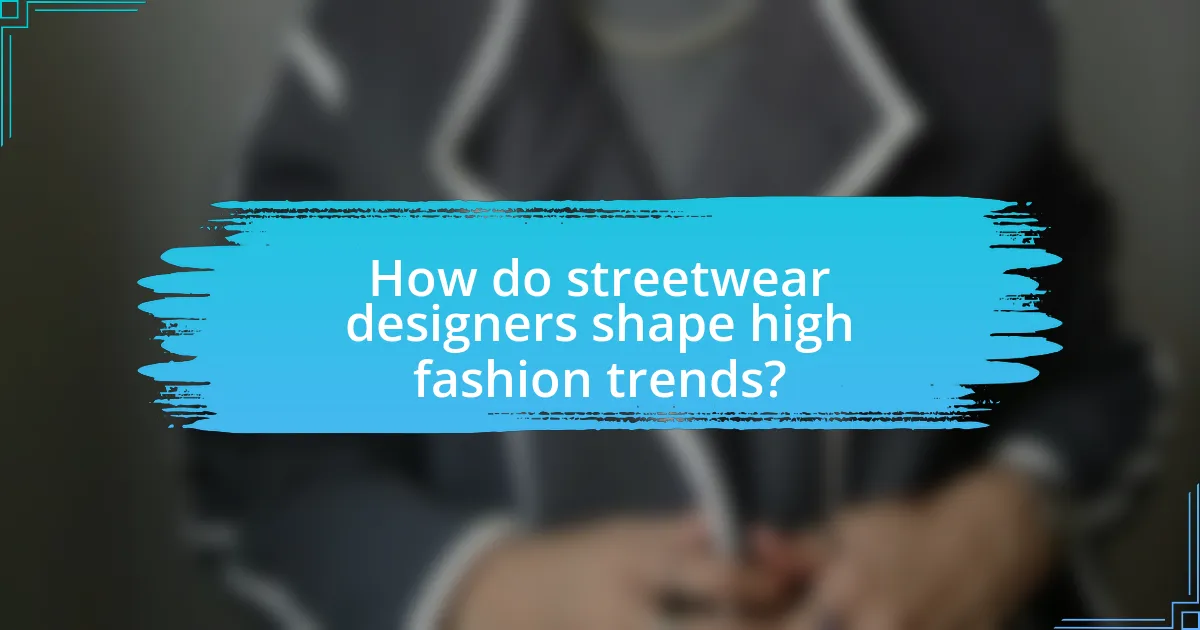
How do streetwear designers shape high fashion trends?
Streetwear designers shape high fashion trends by introducing casual, urban aesthetics that challenge traditional luxury norms. This influence is evident in collaborations between streetwear brands and high-end fashion houses, such as the partnership between Off-White and Louis Vuitton, which merges street culture with luxury craftsmanship. Additionally, streetwear’s emphasis on limited releases and exclusivity has prompted high fashion to adopt similar marketing strategies, creating a sense of urgency and desirability. The rise of social media platforms has further amplified this impact, allowing streetwear designers to reach a global audience and set trends that high fashion often follows.
What specific trends have been popularized by streetwear designers?
Streetwear designers have popularized several specific trends, including oversized silhouettes, graphic-heavy designs, and the blending of high fashion with casual wear. Oversized silhouettes have become a hallmark of streetwear, characterized by baggy pants and loose-fitting tops, which challenge traditional tailoring norms. Graphic-heavy designs often feature bold logos, artwork, and slogans, reflecting urban culture and personal expression. Additionally, the fusion of high fashion elements with casual streetwear, exemplified by collaborations between luxury brands and streetwear labels, has blurred the lines between formal and informal attire, making luxury more accessible. These trends have significantly influenced mainstream fashion, as seen in collections from brands like Off-White and Supreme, which have garnered widespread acclaim and adoption in high fashion circles.
How have graphic tees and oversized silhouettes changed high fashion collections?
Graphic tees and oversized silhouettes have significantly transformed high fashion collections by introducing a more casual and accessible aesthetic. This shift has blurred the lines between luxury and streetwear, allowing designers to incorporate everyday wear into high-end fashion. For instance, brands like Balenciaga and Off-White have embraced oversized fits and graphic designs, reflecting a cultural movement towards comfort and self-expression. The rise of these elements has led to increased collaborations between streetwear and luxury brands, further validating their impact on high fashion.
What impact do sneaker culture and athleisure have on high fashion?
Sneaker culture and athleisure significantly influence high fashion by integrating casual, sporty aesthetics into luxury design. This shift is evident in collaborations between high-end brands and sneaker companies, such as the partnership between Adidas and designer Yohji Yamamoto, which merges street style with high fashion. Additionally, the rise of athleisure has led luxury brands like Gucci and Balenciaga to incorporate comfortable, athletic-inspired pieces into their collections, reflecting a broader trend towards functionality and wearability in high fashion. This evolution is supported by market data indicating that the global athleisure market is projected to reach $257.1 billion by 2024, highlighting the growing consumer demand for stylish yet comfortable clothing.
How do streetwear designers utilize social media to influence high fashion?
Streetwear designers utilize social media to influence high fashion by leveraging platforms like Instagram and TikTok to showcase their collections, engage with audiences, and create viral trends. These designers often collaborate with influencers and celebrities, amplifying their reach and establishing a direct connection with consumers. For instance, brands like Off-White and Supreme have successfully used social media campaigns to generate buzz and drive demand, evidenced by their limited releases often selling out within minutes. This strategy not only democratizes fashion but also blurs the lines between streetwear and high fashion, as traditional luxury brands increasingly adopt streetwear aesthetics to remain relevant in a rapidly evolving market.
What platforms are most effective for streetwear designers in shaping trends?
Social media platforms, particularly Instagram and TikTok, are the most effective for streetwear designers in shaping trends. These platforms allow designers to showcase their collections, engage with audiences, and leverage influencer partnerships to amplify their reach. For instance, Instagram’s visual-centric format enables designers to create compelling content that resonates with fashion enthusiasts, while TikTok’s viral nature allows for rapid trend dissemination through short, engaging videos. According to a 2021 study by Business of Fashion, 70% of consumers reported discovering new fashion brands through social media, highlighting its critical role in trend formation within the streetwear sector.
How does influencer marketing play a role in the streetwear and high fashion relationship?
Influencer marketing significantly bridges the gap between streetwear and high fashion by leveraging social media platforms to amplify brand visibility and consumer engagement. Influencers, often seen as trendsetters, create authentic connections with their followers, which helps streetwear brands gain credibility and reach a wider audience. For instance, collaborations between high fashion houses and streetwear influencers, such as Virgil Abloh’s work with Louis Vuitton, demonstrate how influencer marketing can elevate streetwear’s status within the luxury market. This synergy not only drives sales but also shapes consumer perceptions, making streetwear a vital component of high fashion’s evolving landscape.
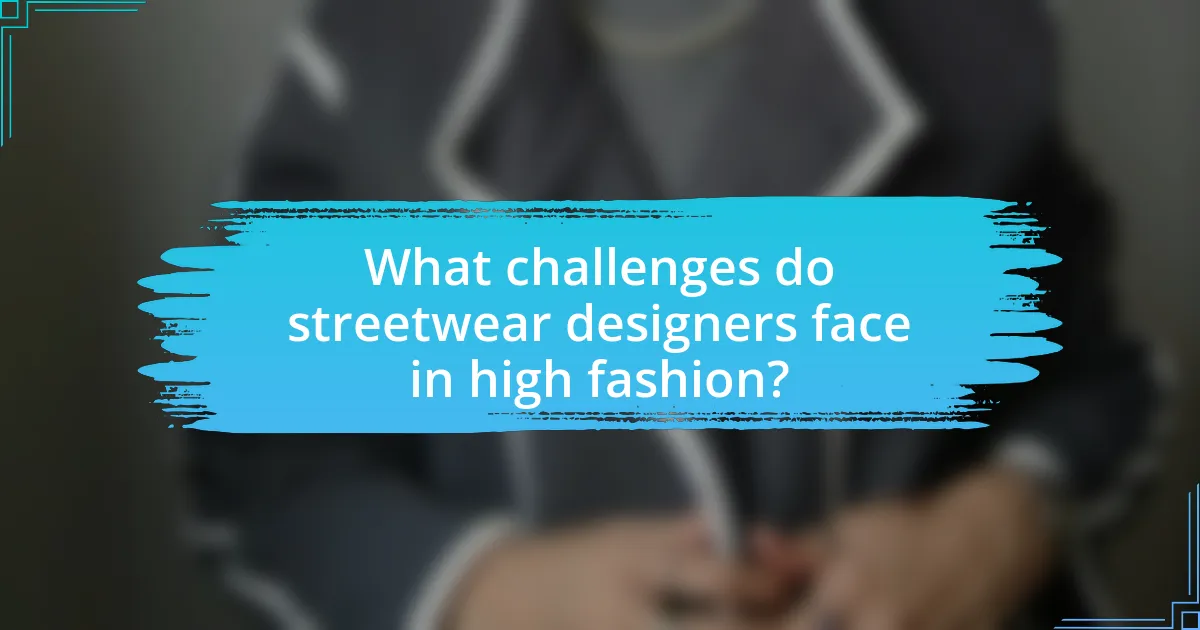
What challenges do streetwear designers face in high fashion?
Streetwear designers face significant challenges in high fashion, primarily due to the clash of cultural values and market expectations. High fashion often emphasizes exclusivity and luxury, while streetwear is rooted in accessibility and youth culture. This fundamental difference can lead to tensions in brand identity and consumer perception. Additionally, streetwear designers must navigate the established hierarchies and gatekeeping prevalent in high fashion, which can hinder their ability to gain recognition and legitimacy. The competition from traditional luxury brands, which have more resources and established reputations, further complicates the landscape for streetwear designers aiming to break into high fashion.
How do streetwear designers navigate the luxury market?
Streetwear designers navigate the luxury market by blending casual aesthetics with high-end craftsmanship, creating products that appeal to both street culture and luxury consumers. This approach allows them to leverage the exclusivity and desirability associated with luxury brands while maintaining the accessibility and relatability of streetwear. For instance, collaborations between streetwear brands like Off-White and luxury houses such as Louis Vuitton have demonstrated how merging these two worlds can result in significant commercial success and cultural impact, evidenced by the high resale values of their products. Additionally, streetwear designers often utilize limited releases and unique branding strategies to create a sense of urgency and exclusivity, further solidifying their position within the luxury market.
What are the barriers to entry for streetwear brands in high fashion?
Barriers to entry for streetwear brands in high fashion include established brand prestige, distribution challenges, and consumer perception. Established high fashion brands possess significant market recognition and loyalty, making it difficult for new streetwear brands to gain visibility. Additionally, streetwear brands often face challenges in securing distribution channels that align with high fashion standards, as luxury retailers typically prioritize established labels. Consumer perception also plays a crucial role; many high fashion consumers may view streetwear as less prestigious, which can hinder acceptance in luxury markets. These factors collectively create a challenging environment for streetwear brands attempting to penetrate high fashion.
How do streetwear designers maintain authenticity while appealing to luxury consumers?
Streetwear designers maintain authenticity while appealing to luxury consumers by integrating cultural elements and grassroots influences into their collections. This approach ensures that the designs resonate with the original streetwear ethos, which is rooted in community and self-expression. For instance, brands like Off-White and Fear of God have successfully blended high-quality materials and craftsmanship with street-inspired aesthetics, allowing them to attract luxury consumers without compromising their foundational identity. The collaboration between streetwear and luxury brands, such as the partnership between Louis Vuitton and Off-White’s Virgil Abloh, exemplifies this balance, as it merges high fashion’s exclusivity with streetwear’s accessibility and cultural relevance.
What criticisms do streetwear designers face from the fashion industry?
Streetwear designers face criticisms from the fashion industry primarily for perceived lack of originality and over-commercialization. Critics argue that many streetwear brands rely heavily on established logos and graphics, which can lead to accusations of copying high fashion elements without adding significant innovation. Additionally, the rapid production cycles and collaborations with mass-market retailers are seen as diluting the exclusivity and artistry traditionally associated with fashion design. This commercialization often prioritizes profit over creativity, leading to concerns about the sustainability of the streetwear movement within the broader fashion landscape.
How is the commercialization of streetwear viewed by traditional fashion critics?
Traditional fashion critics often view the commercialization of streetwear as a dilution of its original cultural significance and authenticity. Critics argue that the mass production and marketing of streetwear undermine its roots in subcultures and grassroots movements, transforming it into a commodity rather than a form of self-expression. For instance, the rise of luxury brands collaborating with streetwear labels, such as Louis Vuitton’s partnership with Supreme, has sparked debates about the integrity of streetwear as it becomes increasingly mainstream. This commercialization is seen by some as a departure from the rebellious spirit that characterized early streetwear, leading to concerns about the loss of its unique identity and the potential exploitation of its cultural origins.
What are the implications of cultural appropriation in streetwear design?
Cultural appropriation in streetwear design often leads to significant ethical and social implications, including the commodification of marginalized cultures. This practice can result in the dilution of cultural significance, where traditional symbols and styles are used without understanding or respect for their origins. For instance, brands like Urban Outfitters have faced backlash for using Native American motifs in their clothing lines, which many argue trivializes the cultural heritage and struggles of Indigenous peoples. Additionally, cultural appropriation can perpetuate stereotypes and reinforce power imbalances, as dominant cultures profit from the aesthetics of marginalized groups while failing to acknowledge their contributions. This dynamic raises questions about authenticity and respect in the fashion industry, highlighting the need for greater awareness and sensitivity among designers.
What practical strategies can streetwear designers employ to succeed in high fashion?
Streetwear designers can succeed in high fashion by leveraging collaborations with established luxury brands, which enhances their visibility and credibility. Collaborations, such as the partnership between Off-White and Louis Vuitton, demonstrate how merging streetwear aesthetics with high fashion can attract diverse consumer bases and elevate brand status. Additionally, streetwear designers should focus on limited-edition releases to create exclusivity, as seen with brands like Supreme, which drives demand and fosters a sense of urgency among consumers. Emphasizing sustainability and ethical practices can also resonate with modern consumers, as high fashion increasingly prioritizes these values. By integrating these strategies, streetwear designers can effectively navigate and thrive within the high fashion landscape.
How can streetwear designers effectively collaborate with high fashion brands?
Streetwear designers can effectively collaborate with high fashion brands by leveraging their unique cultural insights and innovative aesthetics to create limited-edition collections that appeal to both markets. This approach has been validated by successful partnerships, such as the collaboration between Off-White and Louis Vuitton, which combined streetwear’s casual style with luxury craftsmanship, resulting in a collection that generated significant media buzz and sales. Additionally, incorporating social media marketing strategies can enhance visibility and engagement, as seen in the partnership between Supreme and The North Face, which utilized social platforms to create hype and demand. These collaborations not only bridge the gap between casual and luxury fashion but also reflect the evolving consumer preferences towards more inclusive and diverse fashion narratives.
What best practices should streetwear designers follow to maintain their unique identity?
Streetwear designers should prioritize authenticity and originality to maintain their unique identity. This involves creating designs that reflect personal experiences, cultural influences, and social commentary, which resonate with their target audience. For instance, brands like Supreme and Off-White have successfully carved out distinct identities by incorporating elements of skate culture and art into their collections, thus establishing a strong brand narrative. Additionally, engaging with the community through collaborations and limited releases fosters a sense of exclusivity and loyalty, further solidifying their unique position in the market.





